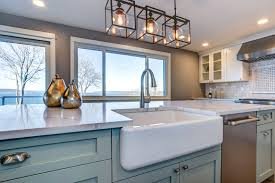The Ultimate Guide to Farmhouse Sinks: Style, Functionality, and Everything in Between

Introduction: What is a Farmhouse Sink?
A farmhouse sink, also known as an apron-front sink, has become a popular kitchen staple that blends vintage charm with modern functionality. Its standout feature is the deep basin and exposed front that juts out slightly from the edge of the countertop. Originally found in rural farmhouses—hence the name—this type of sink was designed to hold large amounts of water and make washing up easier without causing back strain.
What makes farmhouse sinks so appealing is their balance between beauty and practicality. Whether you’re going for a rustic country vibe or a sleek contemporary look, there’s a farmhouse sink style to match your kitchen. They’re big, bold, and make a serious design statement.
Over the years, this classic sink has evolved, and now it comes in various materials, colors, and configurations. But before you rush to install one in your home, it’s important to understand the pros, cons, and what to expect when adding a farmhouse sink to your kitchen.
The Aesthetic Appeal: Why Farmhouse Sinks Are Loved by Designers

One of the biggest reasons farmhouse sinks have become a kitchen trend is their undeniable aesthetic appeal. Their distinctive exposed front and oversized bowl instantly add character to any kitchen layout. Designers often choose them as a focal point in the kitchen, and for good reason—they catch the eye while offering functionality.
Farmhouse sinks work well with a variety of kitchen styles. They blend beautifully in rustic or cottage-style kitchens but can also be the perfect contrast in a modern or industrial space. Their bold shape adds texture and depth to a room that might otherwise feel flat or generic.
In addition to style, farmhouse sinks offer that charming, old-world feel. They make the kitchen feel warm, lived-in, and authentic. If you’re renovating or designing your kitchen, installing a farmhouse sink is a great way to elevate your space without going overboard.
Materials Matter: Choosing the Right Farmhouse Sink
Farmhouse sinks are available in a wide range of materials, and the one you choose will significantly impact both the look and performance of your sink. The most common materials include fireclay, stainless steel, cast iron, copper, and even stone. Each has its pros and cons.
Fireclay is a classic material often associated with farmhouse sinks. It’s made by molding ceramic clay and then firing it at an extremely high temperature. This makes it durable and resistant to scratches, chips, and stains. It has a smooth, glossy surface that is easy to clean and very attractive.
Stainless steel farmhouse sinks offer a modern take on the classic design. They’re lightweight, durable, and less expensive than some other materials. Stainless steel is especially great for busy households since it’s easy to maintain and matches most kitchen appliances.
Copper and cast iron are more unique and visually striking but come with maintenance challenges. Copper develops a natural patina over time, which can add character but might not be everyone’s taste. Cast iron, while stunning and extremely tough, is very heavy and requires proper support during installation.
Ultimately, your choice depends on your kitchen style, your budget, and how much maintenance you’re willing to take on.
Size and Configuration: Finding the Perfect Fit
When it comes to farmhouse sinks, size does matter. One of the main draws is the deep, wide basin that makes washing large pots and pans a breeze. Most farmhouse sinks come in 30″, 33″, or 36″ widths, but custom sizes are also available for unique kitchen layouts.
You’ll also need to decide between single-basin and double-basin configurations. A single-basin farmhouse sink offers a large, uninterrupted space, perfect for soaking baking sheets or prepping large meals. Double-basin sinks, on the other hand, allow for multitasking—you can wash dishes on one side while rinsing vegetables on the other.
Installation can also vary. While most farmhouse sinks are undermount (sitting below the countertop), some can be flush-mounted or even top-mounted depending on your cabinetry and countertop setup. It’s essential to measure your cabinet size carefully and consult a contractor if you’re unsure.
Keep in mind that a farmhouse sink usually requires a special cabinet design to support its weight and dimensions. If you’re remodeling an existing kitchen, you may need to adjust your cabinetry to accommodate it.
Installation Tips: What to Expect
Installing a farmhouse sink is a bit more involved than a traditional sink installation. Because of its size and weight, it typically requires reinforced cabinetry and professional fitting. If you’re working with an older kitchen, modifications might be necessary to accommodate the apron-front style.
Start by measuring your current sink base cabinet. Farmhouse sinks often need a deeper and wider cabinet than standard sinks. You’ll also need to consider how the sink will interact with your countertop. Some materials like granite or quartz can be cut to fit precisely, while others might need more careful planning.
Waterproofing is another concern. Because farmhouse sinks sit flush or slightly forward from the counter, there’s a higher chance of water splashing out onto your cabinets or floors. Adding a waterproof barrier or proper caulking around the edges can prevent water damage.
If you’re going the DIY route, make sure you have the proper tools and experience. For most people, hiring a pro is the safest route to ensure a snug, leak-free fit.
Functionality and Everyday Use
Beyond just looking great, farmhouse sinks are incredibly practical. The deep basin makes washing dishes easier and less messy. You can soak large pots and pans without tilting them awkwardly. The apron-front design also brings the sink closer to the user, which means less leaning over and less back strain during long dishwashing sessions.
If you love cooking or entertaining, you’ll appreciate the extra space. Whether you’re defrosting a turkey or prepping vegetables, the roomy interior is a real game changer.
However, with that extra space comes a bit of extra maintenance. Food scraps, water stains, and residue can accumulate more quickly in a larger basin. That’s why it’s important to rinse and wipe it down regularly. Some materials, like fireclay or copper, need a bit more TLC to stay looking their best.
Pros and Cons: Is a Farmhouse Sink Right for You?
Like any kitchen fixture, farmhouse sinks come with their fair share of pros and cons. Knowing these can help you decide whether this sink style fits your lifestyle.
Pros:
- Timeless, stylish appearance
- Deep basin for more functionality
- Adds value to your kitchen
- Comfortable use with reduced back strain
- Perfect for large families or frequent cooks
Cons:
- Heavier and bulkier than traditional sinks
- More expensive, especially in premium materials
- Requires special cabinetry and support
- Can cause water splash if not installed properly
- Some materials require extra maintenance
While these sinks are undeniably beautiful and useful, they might not be ideal for everyone. If you have a small kitchen or aren’t planning to update your cabinets, a farmhouse sink might feel overwhelming or difficult to install.
Conclusion: The Perfect Blend of Charm and Utility
Farmhouse sinks aren’t just a passing trend—they’re a smart investment for homeowners who value both style and function. Their generous size, elegant look, and comfortable design make them a beloved choice in kitchens around the world. Whether you’re doing a full renovation or just swapping out your old sink, a farmhouse sink can instantly elevate the look and feel of your space.
Before making your decision, weigh the costs, materials, and installation requirements carefully. But if you’re looking for a sink that’s as practical as it is beautiful, farmhouse sink the farmhouse sink might be exactly what your kitchen needs.



